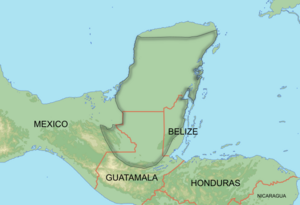Yucatan squirrel facts for kids
Quick facts for kids Yucatan squirrel |
|
|---|---|
 |
|
| Conservation status | |
| Scientific classification | |
| Genus: |
Sciurus
|
| Species: |
yucatanensis
|
| Subspecies | |
|
|
 |
|
| range of the Yucatan squirrel | |
| Synonyms | |
|
Sciurus carolinensis var. yucatanensis J.A. Allen, 1877 |
|
The Yucatan squirrel (Sciurus yucatanensis) is a type of tree squirrel. It lives in the Yucatán Peninsula and nearby areas. You can find this squirrel in northern Belize, northeastern Guatemala, and southeast Mexico. It was once called the Yucatan gray squirrel or the Campeche squirrel.
Contents
Where They Live and What They Do
Yucatan squirrels live in different kinds of forests. These include dry forests, evergreen forests, and pine-oak woodlands. They also live in areas where trees have grown back after logging. You will find them in lowlands, usually below 750 meters (2,460 feet) high.
These squirrels are active during the day. They spend most of their time climbing and resting in trees. They are busiest in the early morning. Sometimes, you might see them sunbathing on a tree branch later in the day.
Food and Home
Yucatan squirrels build their nests, called dreys, high up in tree branches. They make these nests from leaves and twigs.
Their diet includes soft fruits, nuts, and seeds. Some studies suggest they also eat flowers, buds, and young shoots.
Reproduction and Family Life
Female Yucatan squirrels usually have two or three babies at a time. They give birth during the dry season, which is from April to August.
Natural Enemies
Many animals hunt Yucatan squirrels. These include birds of prey (like eagles and hawks). Wild cats and dogs also hunt them. Other predators are procyonids (like raccoons), primates (like monkeys), and snakes.
What They Look Like
The Yucatan squirrel is about 45 to 50 centimeters (18 to 20 inches) long. This makes it bigger than the common Eastern gray squirrel. Its tail is quite long, about 24 centimeters (9.4 inches). Both male and female squirrels are about the same size. They weigh between 341 and 475 grams (12 to 16.8 ounces).
Their fur feels rough. The top part of their body is black and gray. It can also have yellow or buff (a yellowish-brown) colors. Their belly is off-white, yellow-gray, and black. The tail is white with clear black lines. The hairs on their tail are shorter than on their body.
Their face has a buff-colored patch above the nose. The sides of their head are mostly black. Their ears are narrow and pointed. They are gray, brown, and white. In some seasons, their ears have off-white tufts of fur.
Different Types of Yucatan Squirrels
Scientists have identified three different types, or subspecies, of the Yucatan squirrel. They all look a bit different and live in slightly different areas.
- The first type, S. yucatanensis yucatanensis, lives in the Yucatán Peninsula. This includes parts of Mexico and northern Belize. It lives in dry woodlands.
- The second type, S. yucatanensis baliolus, lives southwest of the first type's area. It has darker fur and prefers more moist, evergreen forests.
- The third type, S. yucatanensis phaeopus, is the darkest of the three. It has black legs, tail, and black fur at the base of its ears. This type lives in parts of Mexico, Guatemala, and Belize. It was first found in pine-oak woodlands.
Yucatan Squirrels and People
People's actions can affect Yucatan squirrels. Cutting down forests, known as deforestation, is a big problem for them. Hunting can also reduce their numbers, especially in the northern Yucatán Peninsula.


